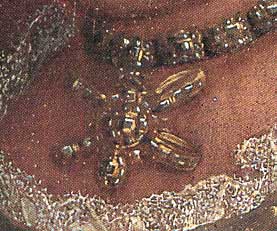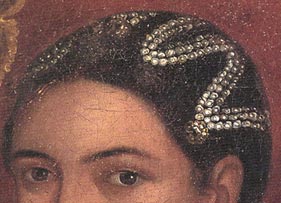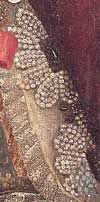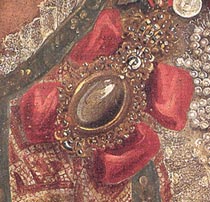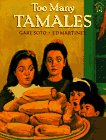
Introduction/Overview:
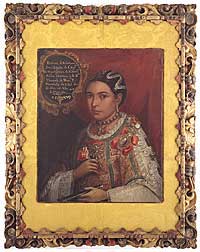 |
This lesson
will begin with an examination of the exhibit piece, Portrait
of an Indian Lady.
Discussion will center around the caste system of viceregal Mexico and the limited life choices of women at that time. At age sixteen, women had two life choices: to marry or enter the convent. After discussing the portrait and the history, students will write a persuasive composition about making life choices at the age of sixteen. |
Learning Objectives:
Students will
- Identify characteristics of a caste system
- Write a persuasive composition regarding decisions based on social class
Suggested Activities/Procedures:
1. Set background and purpose
a. Show students the painting, Portrait of an Indian Lady. Discuss that the subject of the painting is a 16-year-old girl from a wealthy section of the one of the lowest caste of the population (the indigenous Indians). Her father was a governor. Girls in this era had 2 choices at age 16: to marry or to enter the convent. She is about to enter the convent that was designated only for the indigenous class. Other convents were designed for members of other classes.
Discuss her dress and jewelry, which are elaborate. Wearing them is probably her last extravagance before giving up her worldly possessions and taking her religious vows. Ask the students what their opinion is about this serious a decision being made at age 16.
Detail of her necklace xx Detail of pearls in her hair b. For background on viceregal Mexico, have the students explore the site, Mexico Viceregal History for Kids
http://www.elbalero.gob.mx/kids/history/html/colonia/mexvirrey.html (link opens new browser window)
2. Brainstorminga. Brainstorm the concept of a caste system. Check meaning in dictionary: (a division of society based on differences of wealth, inherited rank or privilege, profession, or occupation).
b. Look at the portrait and discuss the appearance of the indigenous woman. Does the artist convey the concept of a lower caste member in his work? How do you think the artist felt about his subject?
3. Prewriting activities
a. Have students explore the website:
http://members.aol.com/MrDonnUnits/ColonialMexico.html#INTRO (link opens new browser window)
to learn more about the caste system of this era.b. Discuss the importance of religion in viceregal Mexico and show students pictures of typical convents of the era:
http://scils.rutgers.edu/~rsantil/juana37.html (link opens new browser window)
http://scils.rutgers.edu/~rsantil/juana44.html (link opens new browser window)4. Composing
Give the students the following prompt and planning sheet:
"In viceregal Mexico, life changing decisions were made at the age of 16, based on the caste or social group to which they belonged. Do you think that choosing a career at age 16, based on social class, would be a wise practice in the present time? What is your position on this issue?
Write a letter to the editor or a newspaper stating your position and supporting it with convincing reasons. Be sure to explain your reasons in detail."5. Revision
Students will use available materials to revise their piece for word choice, organization, voice and sentence structure.
6. Editing
Students will edit piece for spelling, capitalization and punctuation. (Conventions)
7. Publishing
Students will complete a final copy of their story for grading.
Extending the Lesson:
Students with limited background or limited English proficiency:
Read aloud Too Many Tamales by Gary Soto.
Access the teacher's Cyber Guide: http://www.sdcoe.k12.ca.us/score/too/tootg.html
Content Connections for Too Many Tamales:
http://www.mcps.k12.md.us/curriculum/socialstd/MBD/Too_Tamales.html
- Use Story Map form in PDF format (download the free Acrobat Reader to view) to discuss story elements to check for understanding.
- Ask the students about the fact that Maria took her mother's ring without permission.
- Give the students the following prompt:
"Do you think it is right for someone to borrow someone else's belongings without asking even if they intend to return it?"- Ask each student to write and illustrate a paragraph with his or her answer. Compile student work into a class book.
Advanced students could complete any of the following extensions:
- Create a poem about your dreams for your future
- Write a research report on a career that interests you.
- Create a brochure for a company that you would like to form.
- Additional reading: Research the life of Sor Juana Inés de La Cruz (1648 - 1695).
http://www.pinn.net/~sunshine/march99/cruz2.html (link opens new browser window)
She was known as the Poet Nun who was considered a genius and revolutionary thinker.
Read excerpts from her poetry:
http://www.sappho.com/poetry/historical/j_ines.html (link opens new browser window)
Sor Juana was one of the first feminists. Research the Feminist Movement and compare its principals to the ideas of the Poet Nun.
Time Required: 1 week
Curriculum Standards:
National Council of Teachers of English (NCTE)/International Reading Association (IRA)
4. Students adjust their use of spoken, written, and visual language (e.g., conventions, style, vocabulary) to communicate effectively with a variety of audiences and for different purposes.
5. Students employ a wide range of strategies as they write and use different writing process elements appropriately to communicate with different
audiences for a variety of purposes.6. Students apply knowledge of language structure, language conventions (e.g. spelling and punctuation), media techniques, figurative language, and genre to create, critique, and discuss print and non-print texts.
Texas Essential Knowledge and Skills (TEKS)
TEKS: (6.15) (7.15) (8.15) Writing/purposes. The student writes for a variety of audiences and purposes and in a variety of forms. The student is expected to:
(B) write to influence such as to persuade, argue, and request (4-8);TEKS: (6.19) (7.19) (8.19) Writing/writing processes. The student selects and uses writing processes for self-initiated and assigned writing.
TEKS: (6.16) (7.16) (8.16) Writing/penmanship/capitalization/punctuation. The student composes original texts, applying the conventions of written language, such as capitalization, punctuation, and penmanship, to communicate clearly.
Evaluation/Assessment: Use the 6 Trait Model to assess compositions.
- Assessment rubric in PDF format (download the free Acrobat Reader to view)
Tips for the Teacher:
- Brainstorming sessions on making career choices may be conducted in small cooperative groups and shared with the class as oral presentations.
- Picture
books about facing challenges (link opens new browser
window)
These can be shared as a prewriting activity. - The 6 Trait Model
- Information
on 6 Trait +1 Writing™ and assessment:
http://www.nwrel.org/assessment/about.asp?odelay=1&d=1 (link opens new browser window)
- Information
on 6 Trait +1 Writing™ and assessment:
- References of
books to help teaching 6 Traits:
http://6traits.cyberspaces.net/books.html (link opens new browser window)
Student Materials:
- Student planning sheet for persuasive writing in PDF (download the free Acrobat Reader to view)
Lesson Plan Sources:
Books:
- Burgess, Betsy, and Laurie Swiryn. Internet Quests Web Activities Across the Curriculum. Teacher Created Materials: Westminster, 2001.
- Fountas, Irene C. and Gay Su Pinnell. Guiding Readers and Writers. Heinemann. Portsmouth, NH: 2001.
- Hill, Bonnie Campbell, Katherine Schlick Noe and Nancy J. Johnson. Literature Circles Resource Guide Teaching Suggestions, Forms, Sample Book Lists and Database. Christopher-Gordon Publishers. Norwood, MA: 2000.
- Lukens, Rebecca J. A Critical Handbook of Children's Literature. Addison Wesley. New York: 1999:
Web sites:
- Viceregal Mexico
http://www.elbalero.gob.mx/kids/history/html/colonia/mexvirrey.html (link opens new browser window)- History of Mexico
http://home.carolina.rr.com/wormold/mexico/history-5.htm (link opens new browser window)- Colonial Mexico
http://www.mexican-embassy.dk/history.html#colonial (link opens new browser window)- Map of ViceRegal Mexico
http://www.humanities-interactive.org/splendors/enhanced/ex048_10e_rgb150.jpg (link opens new browser window)Additional resources on Sor Juana Inés de la Cruz:
- Poetry of Sor Juana Inés de la Cruz
http://www.sappho.com/poetry/historical/j_ines.html (link opens new browser window)- Sor Juana Inés de la Cruz
http://www.orst.edu/instruct/phl302/philosophers/cruz.html (link opens new browser window)- Sor Juana Inés de la Cruz, rebel nun of the 17th century
http://www.lasmujeres.com/sorjuana/rebelnun.shtml (link opens new browser window)- Quiz Kid, Feminist, Nun: The Remarkabale Life of Juana Ines de la Cruz
http://www.mexconnect.com/mex_/history/jtuck/jtjuanainescruz.html (link opens new browser window)- Readings in Early Mexican History
http://www.history.ucsb.edu/syllabi/cline/5-10.html (link opens new browser window)- Sor Juana Inés de La Cruz
http://www.pinn.net/~sunshine/march99/cruz2.html (link opens new browser window)

